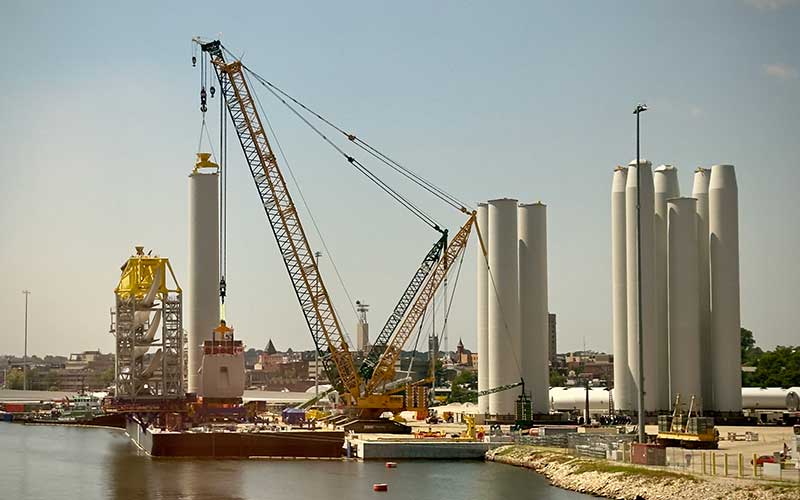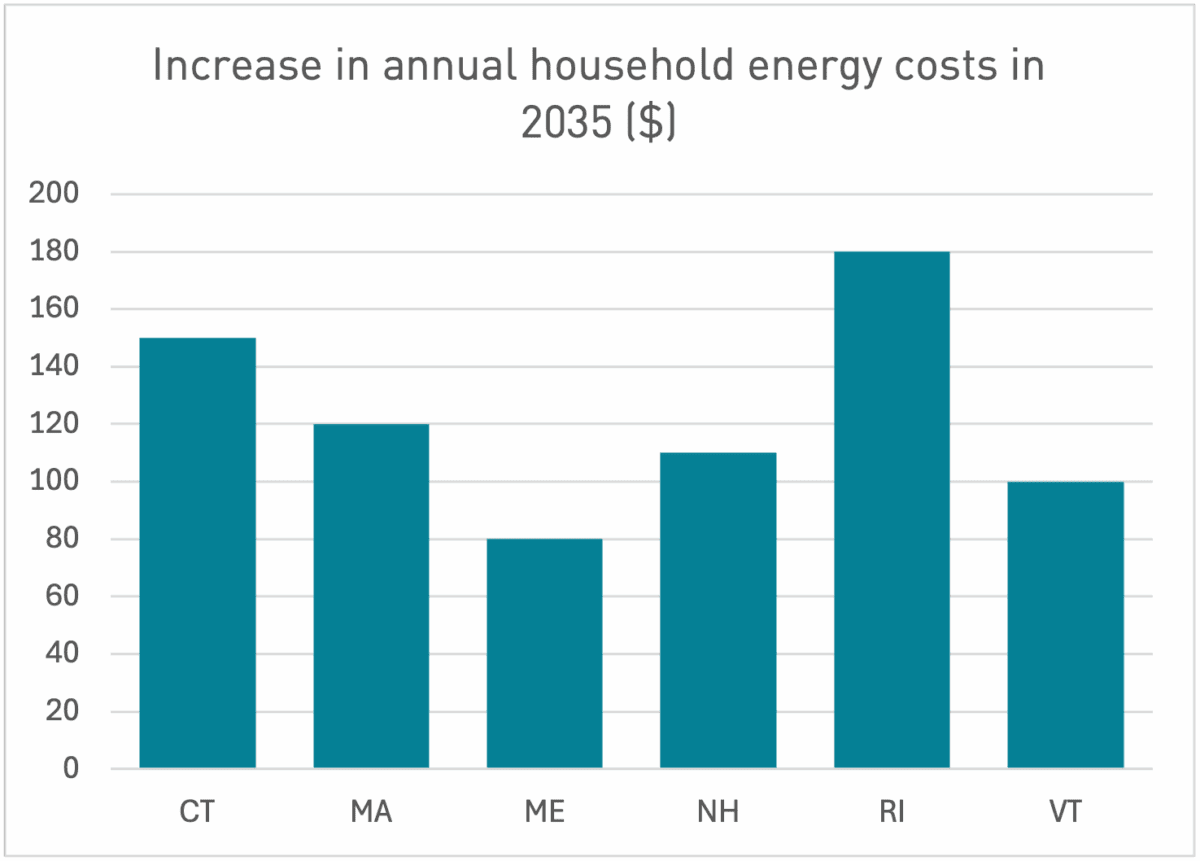
Connecticut joined with offshore wind developers to redevelop the New London State Pier as a turbine assembly and marshaling site. Trump's One Big Beautiful Bill could place the future of the site – and the jobs it created – at risk. Photo: Jamie Flynn
Donald Trump has been tilting at windmills since 2011, when plans emerged to develop a wind farm near his Scottish golf course. On the 2024 campaign trail, he frequently railed against the “green new scam,” criticized electric vehicles and solar panels, and vowed to “end” offshore wind “on Day 1.” On his first day back in office, he suspended all new offshore wind leasing, declared a fake “national energy emergency,” and ordered agencies to withhold congressionally mandated funding for clean energy and climate change.
Another major blow to the growing clean energy economy came on July 4. That’s when Trump signed Republicans’ 10-year partisan budget – the so-called “One Big Beautiful Bill” – which slashes clean energy funding and perpetuates our dependence on fossil fuels.
Here’s our breakdown of this disastrous bill and how we can expect to feel its impacts here in New England. The bottom line: The news isn’t good, but in the end, the clean energy economy is unstoppable.
What Does the “Big Beautiful Bill” Do?
The national implications of the “Big Beautiful Bill” are staggering. To pay for massive tax breaks for corporations and the ultra-wealthy, the bill severely cuts Medicaid and food assistance for families who can’t afford healthcare or groceries. The bill also eliminates hundreds of billions of dollars for clean energy authorized under the 2022 Inflation Reduction Act. Among other things, the bill:
- Rapidly phases out tax credits for wind and solar projects and adds complicated restrictions on foreign-produced components;
- Terminates credits to individuals and businesses to buy electric vehicles and install charging infrastructure;
- Ends home energy efficiency credits designed to reduce energy usage;
- Cancels incentives for developers to build efficient homes and commercial buildings;
- Eliminates credits for rooftop solar, geothermal heating, and battery storage systems that help households reduce energy costs; and
- Rescinds funding for dozens of programs that promote clean energy, help states address climate change, and empower disadvantaged communities to design and implement their own pollution and climate strategies.
At the same time, consistent with Trump’s “drill, baby, drill” mantra, the “Big Beautiful Bill” gives unprecedented handouts to the fossil fuel industry. The bill:
- Mandates onshore and offshore oil and gas leasing, opens sensitive areas for drilling, and expands coal extraction on federal lands;
- Reinstates non-competitive oil and gas leasing, lengthens lease terms, and reduces royalties developers pay to the U.S. Treasury;
- Creates a “pay-to-play” scheme that allows developers to pay a fee in exchange for expedited environmental reviews of their proposed projects;
- Eliminates funding to reduce emissions of methane (a potent greenhouse gas) and delays a fee for methane releases; and
- Provides huge tax breaks to fossil fuel developers.
Three days after signing the bill, Trump ordered the Internal Revenue Service to restrict the use of any remaining clean energy tax credits. He also directed the Department of the Interior to end policies that promote wind and solar energy.
Since then, Trump’s war on clean energy has only escalated. Just this week, the administration announced plans to cut the Biden-era Solar for All program, which aimed to make solar power available to low-income households. The goal is clear: to bully the clean energy industry out of existence and line the pockets of Trump’s fossil fuel donors.
Analysts project that the “Big Beautiful Bill” may kill hundreds of planned wind and solar projects across the country. New clean energy capacity could decrease as much as 59%. U.S. climate-damaging emissions could rise 7% or more compared to the scenario before the bill was enacted.
How Does the “Big Beautiful Bill” Impact New England?
According to a state-level analysis by Energy Innovation, the “Big Beautiful Bill” will slow clean energy deployment, raise household energy costs, and eliminate thousands of jobs across New England.
Lost Renewable Energy Capacity
The “Big Beautiful Bill” will substantially decrease the region’s renewable energy capacity. By 2035, New England will lose 7,340 megawatts of wind, solar, and battery storage capacity, enough to serve roughly three to four million homes. That’s equivalent to the entire population of northern New England. Connecticut and Massachusetts are hit particularly hard, losing 3,900 and 1,800 megawatts, respectively.
Such a drastic cut in local clean energy sources means more reliance on polluting fossil fuels, less energy independence, and higher bills across the region.

Higher Household Energy Bills
Increasing summer heat and the growth of AI data centers are driving up energy demand and consumer costs. Nearly 100% of new electricity resources proposed for New England’s power grid are wind, solar, and battery projects. Without these resources, gas and coal-fired power plants will need to run more frequently. These plants are more expensive to build and operate, so that will drive up prices across the region. Electricity rates could increase as much as 10% by 2035, and New Englanders may pay $100 to nearly $200 more per year for electricity.
At a time when New Englanders already pay some of the highest electricity rates in the country, this is clearly the wrong direction for our communities and our region.

Decreased Economic Activity and Thousands of Lost Jobs
As deployment of new clean energy resources and advanced manufacturing declines, New England will lose out on substantial private investment. The “Big Beautiful Bill” is projected to cost the region nearly $18 billion in economic growth by 2034. Workers will suffer from factory closures and construction halts. Within five years, the bill could result in the loss of nearly 14,000 jobs across New England, including 3,400 in Connecticut and 6,300 in Massachusetts.

The Impacts are Being Felt, but the Clean Energy Transition is Unstoppable
Importantly, this analysis does not consider the administration’s latest attacks on wind and solar energy. Thus, the impacts of Trump’s war on clean energy, many of which will take months or years to materialize, will likely be more severe. But some are already here.
In mid-June, the Maine Governor’s Energy Office asked the state’s utility regulator to indefinitely extend a July deadline to issue its first offshore wind solicitation. The reason? “…recent changes in the energy landscape that have caused significant uncertainty in the offshore wind industry.” On June 30, Massachusetts utilities and two major wind project developers, Avangrid and Ocean Winds, delayed signing contracts for the third time since Trump took office “due to ongoing uncertainty caused by federal level activities.”
The same day, Ocean Winds and a Rhode Island utility delayed their contract for the fourth time. The utility may terminate the project’s selection if negotiations are not successful before November 1. In mid-July, New Leaf Energy, a clean energy developer in Lowell, Massachusetts, laid off 41 employees – a fifth of its workforce – due to “the Federal government’s decision to end the investment tax credit . . . for solar and wind energy.”
The stakes are high for New England, which is counting on wind, solar, and battery storage to provide most of its energy in the future. However, while Trump can slow the transition, clean energy is economically unstoppable. Even without federal incentives, solar and wind are cheaper and faster to build than fossil fuel generators. Now is the time for New England states to double down on their commitments, using bold and smart policies to accelerate the transition to a clean, equitable, and affordable energy future.



